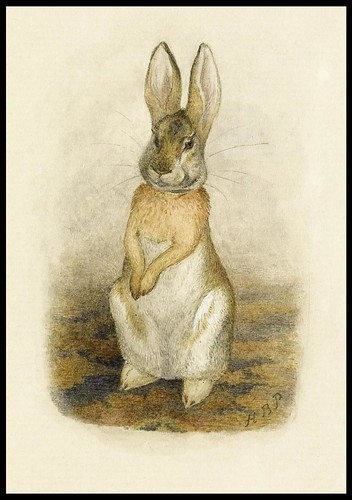
Hare sitting on a patterned carpet
(previously unknown ink, pencil, watercolour/gouache sketch from the early 1890s)Two of the most important pets among Beatrix and Bertram Potter's childhood menagerie were Benjamin Bouncer and, later, Peter Piper. They would become immortalised as Benjamin Bunny and Peter Rabbit. Beatrix Potter used Benjamin Bouncer as a model in the early 1890s for drawing fashionable greeting cards - her first commercial enterprise.

The Rabbits' Christmas Party - The Arrival
The first of a series of six watercolour sketches from 1892, among Potter's finest work. This particular illustration - possibly influenced by Renoir's 'Les Parapluies' - was a gift to Potter's brother Bertram, but was previously unknown. Another version is owned by the Victoria & Albert Museum (V&A) **Nb. See far below for UPDATE**
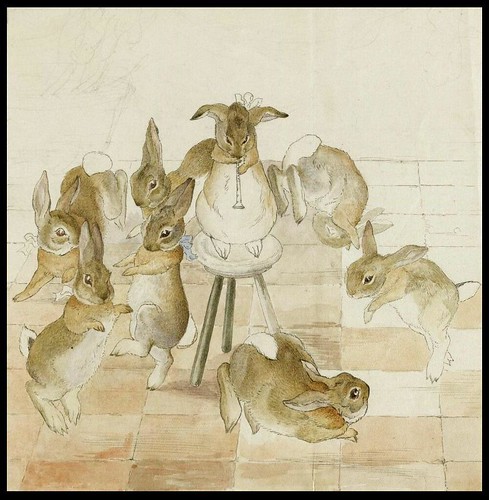

The Rabbits' Christmas Party - Dancing to a Piper
The finished watercolour shows eight rabbits (compared to seven as present here) dancing to a piper. Rhubarb stalks are present in a large pot in the upper left corner. The rhubarb and pot are shown here in faint pencil outline. The floor was changed from evenly laid pinkish terracotta tiles to rather haphazard grey flagstone tiles. this version is entirely unknown.
The scene was later redrawn with a rabbit playing a 'cello surrounded by five dancing rabbits (and two rabbits nuzzling each other by the back wall).
In 1987 Frederick Warne united the four V&A illustrations with the two paintings originally given to Henry P. Coolidge. A fold-out panorama was published as The Rabbits' Christmas Party
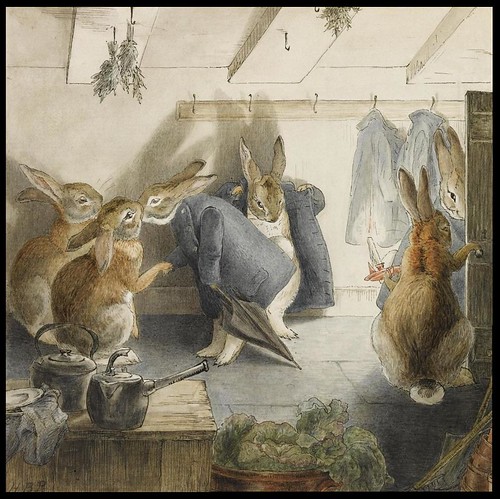
The Rabbits' Christmas Party - The Departure
Hobbs, in the Dulwich Picture Gallery exhibition catalogue, noted "The attitudes are both rabbit-like and human. Only an artist with an intimate knowledge of anatomy could convey so well both musculature and the texture of fur. Remarkable, as in all Potter's animal drawing, is her observation of ears."

Three Little Mice sat down to spin (ink and watercolour)
A booklet (never completed) had been planned for the nursery rhyme, 'Three Little Mice Sat Down to Spin', in which six lines were to be illustrated. The mice in this unfinished sketch are using cottagers' looms. This is a variation on the first work in the series (the watercolour set is at the V&A).


Dinner in Mouseland
(pencil and grisaille drawing heightened with gouache)
The completed version of this work - featuring one of Potter's favourite daisy paintings - is owned by the National Trust was the basis for a scene in The Tale of Johnny Town-Mouse.

Three Rabbits Eating Plenty of Buns
An entirely uknown drawing showing an inventive use of lettering on the jars, bag and label on the set of keys. The message reads "A Merry Christmas and Plenty of Buns H.B.P."
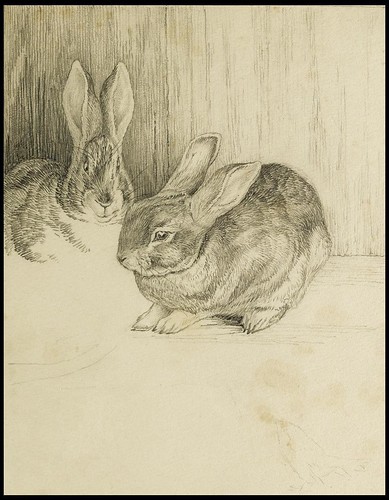

Two Bunnies
Unfinished pencil drawing similar to a version at the V&A that shows two rabbits nibbling a turnip. (the bottom of the image has been trimmed slightly)
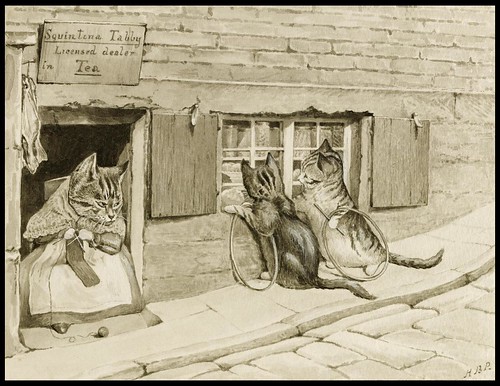

Squintina Tabby - Licensed dealer in Tea
(pen and grisaille drawing heightened with gouache)
(pen and grisaille drawing heightened with gouache)
One of the three variations on this drawing known to exist. Potter's Aunt and Uncle owned a cat called Squintina (Squinty). Dated to about 1895 as a publishing firm adapted the picture that year for a cover of their 'Comical Customers'.
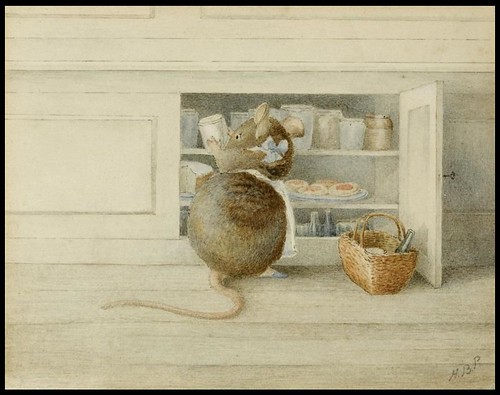


'In somebody's cupboard there's everything nice...'
In 1891 Beatrix Potter drew three illustrations of Appley Dapply intended for publication as greetings cards or as a short booklet. The trio of drawings showed the little brown mouse called Appley Dapply foraging in a larder of food but remained unpublished. In 1917, this specific illustration was noted to be missing as Potter began work on 'Appley Dapply's Nursery Rhymes'. It resurfaced twenty years later and was given as a present to a child known to Potter. {sold for £36,000 - that's Great Britain Pounds, not Euro}

Rough Sketch - The Cats Meat Man
Although this drawing was given away in 1895, Potter remembered the scene thirty years later when the central part of the scene was transformed into the fisher-cart, a line drawing in 'The Fairy Caravan'.
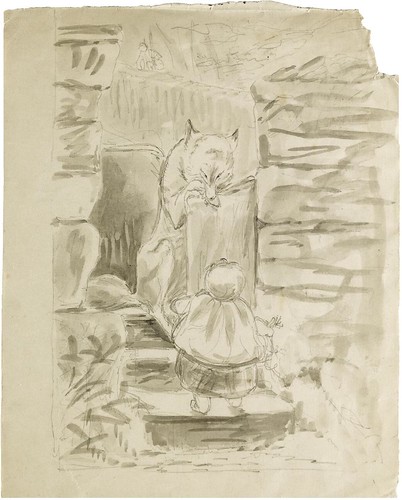
Little Red Riding Hood encounters the Wolf
The completed version of this rough wash drawing contains fungi and ferns to contribute to the feeling of claustrophobia.
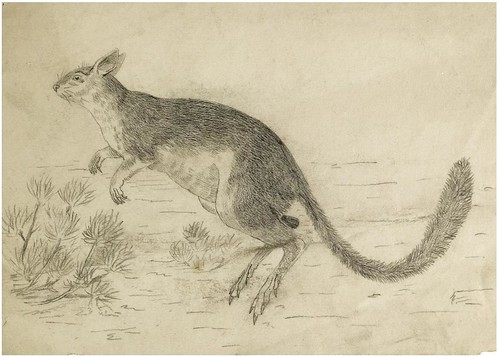
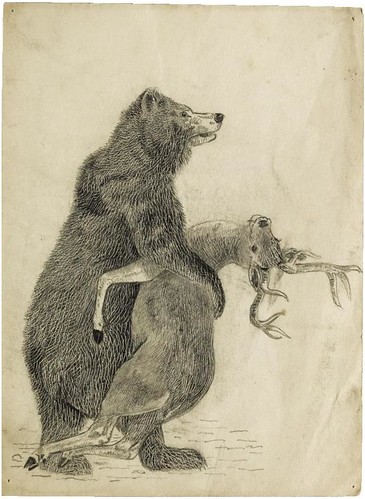
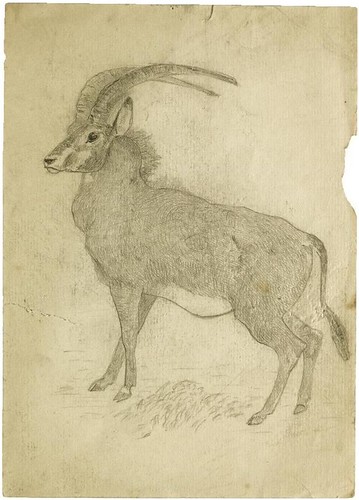
The wallaby, bear clutching a deer and antelope pencil drawings are possibly the result of a visit to the zoo or were copied from illustrations Potter saw in a Victorian natural history book.
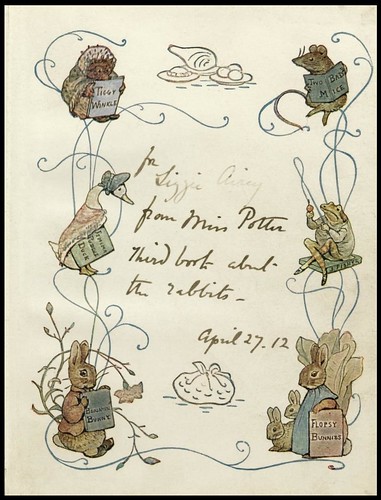
The Tale of the Flopsy Bunnies
From the first edition (1909) presentation book inscribed by Potter with: "for Lizzie Airey from Miss Potter Third book about the rabbits - April 25. 12".
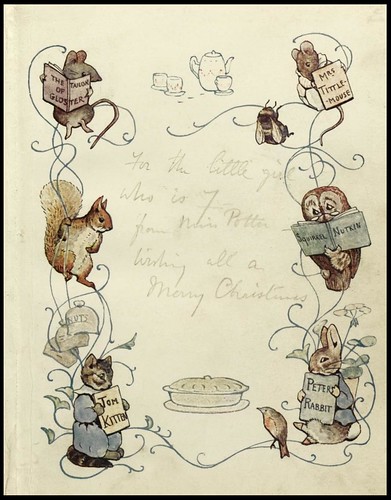
The Tale of Mrs Tittlemouse
From the first edition (1910) presentation book inscribed by Potter with: "For the little girl who is 7 from Miss Potter - Wishing all a Merry Christmas"
The "little girl" was also Lizzie Airey (d. 1985), the daughter of the landlord of the Sun Inn in Hawkshead. The inn's kitchen was the inspiration for the 1912 'Mr Tod's Kitchen'.
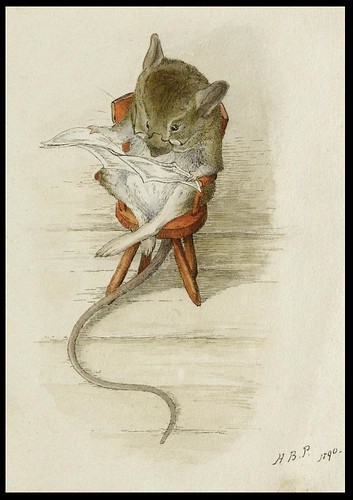
Spectacled Mouse Reading Newspaper
Previously unknown drawing dating from the first year of Potter's association with Hildesheimer & Faulkner greeting card manufacturers (1892). Potter had a fondness for drawing mice reading newspapers, the most famous example being the mouse reading 'The Tailor and the Cutter' in 'The Tailor of Gloucester' [pic].
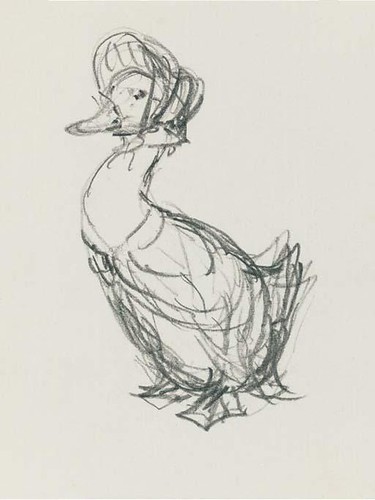
A preparatory sketch for the front cover of The Tale of Jemima Puddle-duck
'The Tale of Jemima Puddle-duck' was published in 1908. [sketch sold for £14,000]

Benjamin Bunny (grey ink and watercolour vignette)
Many of Potter's creations like Peter Rabbit began as characters illustrated in letters or as greeting cards. In 1893 Potter wrote in a letter: "I don't know what to write to you, I will tell you a story about little rabbits whose names were Flopsy, Mopsy, Cottontail and Peter.
'The Tale of Peter Rabbit' was first published privately in 1900 and then commercially, to great success, in 1902. 'The Tale of Benjamin Bunny', which included the character of Peter Rabbit as Benjamin's cousin, followed in 1904. [This sketch from 1893 sold for £30,000 in 2005]
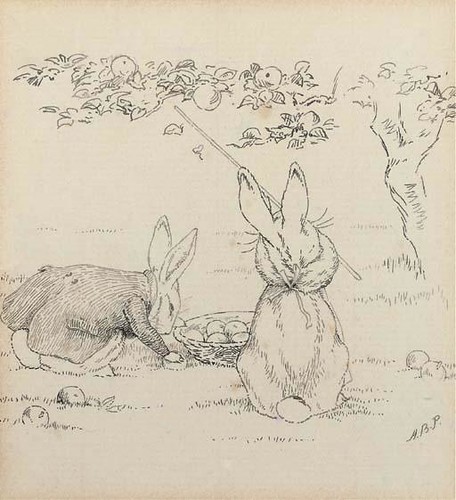
The Strumpers
(black ink; no further details)
(black ink; no further details)

Study of field mice
(pencil, black ink and wash; no further details)
(pencil, black ink and wash; no further details)

Bedstraw and hazlenuts
(pen, brown and watercolour; no further details)
(pen, brown and watercolour; no further details)

Studies for Miss Tiggy-winkle
This pencil drawing is supposed to have come from the nursery at Arundel Castle and was subsequently won in a charity raffle in 1958.
A preliminary sketch for the title page of 'The Tale of Mrs Tiggy-Winkle', 1905.
Mrs Tiggy-Winkle at her washtub inscribed on the back: "original drawing by Beatrix Potter of Mrs Tiggy-Winkle presented to Frederick Ashton by Harold Linder on the occasion of the making of the film 'Tales of Beatrix Potter' Frederick Ashton 1971."
A memento of the collaboration between Leslie Linder, the 'celebrated' Potter scholar and collector, and Frederick Ashton, who had choreographed the ballet and created the part of Mrs Tiggy-Winkle.
[this image (trimmed slightly) was a later addition to the post]

A Study of a House Mouse
(pencil and watercolour heightened with white)
(pencil and watercolour heightened with white)
"Beatrix Potter (1866-1943) drew from an early age, both from nature and from her imagination, often combining the two. From the early 1880's, she made a number of careful studies of bats, lizards and fish, then of insects and spiders, fossils and fungi. Some were wild specimens, but many were pets. Her best-known drawings are of rabbits and mice. 'Benjamin Bouncer' was the inspiration for her first greetings card designs (1890) and the source of her first independent income; a later rabbit, 'Peter Piper', appears in scenes from Alice and Uncle Remus, and then in the Tale of Peter Rabbit (1902), the first of her famous 'Little Books'.
Beatrix Potter grew 'a little tired of rabbits', and came to prefer mice, doormice and voles, as single 'specimens', as sheets of studies in various positions, or, like the rabbits, as protagonists in fairy tale or nursey rhyme illustrations and in her animal fantasies, where they remain faithfully naturalistic.
This drawing may well have been done during a visit to Camfield Place, near Hatfield in Hertfordshire, the house of her paternal grandparents; it is inscribed (on the verso): Oct 29 87. The paper is slightly thicker and more tinted than that used for most of her other natural history studies, except for the larger, more showy finished works done of mechanical wood pulp board. The treatment of eyes, ears and claws are all characteristic; typically, she has used white highlights to render the texture of fur."
[from Christie's catalogue] {sold in 2003 for £7,000}

vignette with no notes in a larger lot

The Tale of Two Bad Mice (1904)
This lavender cloth and gilt inlay book cover was based on a cover design sketched by Potter.{UPDATE: 17 July 2008}:
"LONDON (Reuters) - An original watercolour illustration by Beatrix Potter for the final scene from the Rabbit Christmas Party set a new auction record on Thursday at 289,250 pounds.
The sum was nearly five times the top end of the pre-sale estimate of 40-60,000 pounds, making the painting of rabbits leaving the party by candlelight the most expensive book illustration ever sold at auction, Sotheby's said.
Sotheby's said the buyer was a private British collector.
It was one of 20 original illustrations, books, unpublished Christmas cards and letters by children's author and illustrator Potter from the collection of her brother Bertram Potter on offer at the London sale.
The whole collection, the most extensive group of Beatrix Potter artwork to have appeared on the market in decades, realised a total of 748,200 pounds."
- All images in this post were obtained from fishing expeditions in the archives at Sotheby's and Christie's auction houses. (Sotheby's have an auction featuring some of these works in the next day or so).
- The vast majority of images here were spliced together from (many!) screencaps. A very modest amount of spot/stain reduction was undertaken in most cases, where it was possible and where it 'felt' appropriate. There were no other adjustments or manipulations (unless stated).
- All the above text was adapted or quoted from the respective catalogue entries.
- Copyright and trademark issues enveloping Beatrix Potter's legacy are remarkably convoluted and largely mystifying. I'll just note that, to the extent that I can determine, without having the means to employ a team of barristers, the illustrations themselves appearing in this post would seem to fall outside any residual claims. 'Proceed with caution' is the relevant catchphrase here.
- Online Beatrix Potter Books: University of Virginia Library E-Texts and Project Gutenberg. [I've not looked at these so can't vouch for illustration quality]
- A couple of exhibition sites: Victoria & Albert Museum; Cotsen Library at Princeton University; Women Children's Book Illustrators.
- UPDATE (Jan' 2011): Laura has a great post at Carrington's rare book shop in London - First Editions of Peter Rabbit.
- There are of course many, many Beatrix Potter titles (and books about BP) available from Amazon




No comments:
Post a Comment